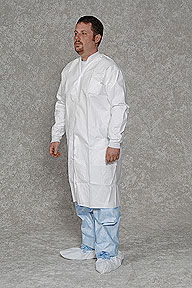Nonwovens Converting: H1N1 Antidote
- Published: February 01, 2010, By Edited by Nsenga Thompson, Associate Editor

After the death of California nurse Karen Ann Hayes last year, the California Nurses Assn. (CNA) released data from 190 facilities in nine states across the US that showed “deficiencies in hospital swine flu readiness,” and called on all hospitals “to adhere to the highest standard of protection for patients and nurses to combat the expected onslaught of new cases this fall and winter.”
According to George Kappler, CEO of Kappler Inc., a 33-year-old protective garment business in Guntersville, AL, “If hospitals were subjected to the same protection standards as factories, many would have been shut down a long time ago.”
Kappler's line of protective garments offers a solution. With $18 million in annual sales and 190 employees, the company designs and manufacturers protective apparel and fabrics for a wide range of global markets and applications, including the world's most dangerous environments, such as chemical factories, military bases, nuclear plants, and hazardous materials (HAZMAT) companies.
Kappler's research and development program has produced more than 30 fabric and seaming technology patents issued or pending worldwide. The company reports it has pioneered many innovations that have redefined global standards for protective apparel.
Using Film that Protects
Kappler's line of healthcare garments, ProVent 10,000, is made from Aptra, a breathable microporous film made in Tiverton, ON, Canada, by BI-AX Inc. BI-AX produces Aptra microporous film under contract for RKW US, Rome, GA, a wholly owned subsidiary of RKW SE in Europe.
Aptra is a breathable film used as a composite with other materials. Though it barely registers on the scales, this unique film is said to provide an exceptional combination of barrier properties and breathability. The film is easily laminated with a wide variety of substrates using several methods.
At Kappler, for instance, the Aptra film is being converted into a three-layer laminate, sandwiched between two layers of spunbond polypropylene to give it strength. The final product passes ASTM international standards for blood-borne pathogen and viral penetration.
Kappler credits Morris Collins, now RKW's US president, with bringing Aptra to him in the early 1990s when Collins was a research engineer. “We always keep our eyes and ears open for new ideas from our customers and suppliers,” says Kappler. “So when Morris introduced us to Aptra, we recognized we could help a lot of healthcare workers with garments that offered more protection than anything else out there.”
ProVent 10,000 customers include the Centers for Disease Control, National Institutes of Health, and orthopedic surgeons and nurses around the world who insist on the best protective clothing for operating theatres where contact, droplet, and airborne transmission of pathogens are a constant risk.
Efforts by front-line healthcare organizations like CNA to increase H1N1 protection standards for their workers have increased the number of inquiries for ProVent 10,000 coveralls, lab coats, gowns, pants, and boot covers.
“Our product has been available to the healthcare market since the early '90s,” says Kappler, “and we always see spikes in interest when something like SARS, or bird flu, and now swine flu hits, but I admit the healthcare field's a much more challenging market than for industrial and security applications where we do most of our business.”
Kappler says healthcare workers are inadequately protected from diseases such as H1N1 because unlike a nuclear contamination incident, it's harder to pinpoint the work environment as the exact source of a life-threatening exposure.
Another reason the protection of front-line healthcare workers is compromised boils down to hospital economics. “A ProVent 10,000 gown costs $7 to $10, and it'll protect against viral diseases like H1N1 as well as blood-borne diseases like HIV,” says Kappler.
“Yet we find it often gets compared to a little yellow gown that sells for a couple of bucks that would let a mosquito go through it. It's like comparing apples to raisins, but some hospitals buy what they can get away with to save a few dollars.”
Kappler maintains the company was ahead of its time when in created ProVent 10,000, but believes now, almost 20 years later, the timing is right. “I do see a lot of promise, but it's still going to take a lot of education to fulfill that promise,” says Kappler. “It takes something like H1N1 to focus people's minds to look for a better solution to the status quo. Well, we've got it right here for them.”
Converter Info
-
Kappler Inc. | 55 Grimes Dr., Guntersville, AL 35976 | 256-505-4005| www.kappler.com
Supplier Info
-
Bi-AX Inc. | www.biaxinc.com
Circle 320 or visit www.freeproductinfo.net/pff








